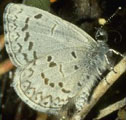Native Plants
Search for native plants by scientific name, common name or family. If you are not sure what you are looking for, try the Combination Search or our Recommended Species lists.
Cornus sericea ssp. sericea
Cornus sericea L. ssp. sericea
Redosier Dogwood, Red Osier Dogwood
Cornaceae (Dogwood Family)
Synonym(s): Cornus alba, Cornus alba ssp. stolonifera, Cornus alba var. baileyi, Cornus alba var. interior, Cornus alba var. sibirica, Cornus baileyi, Cornus instolonea, Cornus interior, Cornus sericea ssp. stolonifera, Cornus sericea var. interior, Cornus stolonifera, Cornus stolonifera var. baileyi, Cornus stolonifera var. coloradensis, Cornus stolonifera var. interior, Cornus stolonifera var. stolonifera, Swida instolonea, Swida sericea, Swida stolonifera
USDA Symbol: COSES
USDA Native Status: L48 (N), AK (N), CAN (N), SPM (N)
Large, spreading, thicket-forming shrub with several stems, clusters of small white flowers, and small whitish fruit; rarely a small tree. Height commonly 3-10 feet (0.9-3 m), rarely to 15 feet (4.6 m). Diameter: 3" (7.5 cm).Leaves are opposite.
Red Osier Dogwood is useful for erosion control on stream banks. The common name recalls the resemblance of the reddish twigs to those of some willows called osiers, used in basketry. Branch tips of this tree will root upon touching the ground.
The genus cornus is Latin for a horn.
Plant Characteristics
Duration: PerennialHabit: Tree
Fruit Type: Drupe
Size Notes: Up to about 15 feet tall, often shorter.
Leaf: Green
Autumn Foliage: yes
Bloom Information
Bloom Color: WhiteBloom Time: Mar , Apr , May , Jun
Distribution
USA: AK , AZ , CA , CO , CT , DE , IA , ID , IL , IN , MA , MD , ME , MI , MN , MT , ND , NE , NH , NJ , NM , NV , NY , OH , OR , PA , RI , SD , UT , VA , VT , WA , WI , WV , WYCanada: NB , NS , PE
Native Distribution: Central Alaska east to Labrador and Newfoundland, south to N. Virginia, and west to California; also N. Mexico; to 5000' (1524 m); to 9000' (2743 m) in the Southwest.
Native Habitat: Moist soils, especially along streams; forming thickets and in understory of forests.
Growing Conditions
Water Use: HighLight Requirement: Sun , Part Shade , Shade
CaCO3 Tolerance: None
Conditions Comments: Red branches attractive.
Benefit
Conspicuous Flowers: yesAttracts: Butterflies
Larval Host: Spring Azure butterfly.
Butterflies and Moths of North America (BAMONA)
|
Spring Azure (Celastrina ladon)  Larval Host |
Find Seed or Plants
View propagation protocol from Native Plants Network.
National Wetland Indicator Status
| Region: | AGCP | AK | AW | CB | EMP | GP | HI | MW | NCNE | WMVE |
| Status: | FACW | FAC | FACW | FACW | FACW | FACW | FACW | FACW |
From the National Organizations Directory
According to the species list provided by Affiliate Organizations, this plant is on display at the following locations:Native Plant Center at Westchester Community College, The - Valhalla, NY
Santa Barbara Botanic Garden - Santa Barbara, CA
Bibliography
Bibref 946 - Gardening with Prairie Plants: How to Create Beautiful Native Landscapes (2002) Wasowski, SallySearch More Titles in Bibliography
Web Reference
Webref 38 - Flora of North America (2019) Missouri Botanical Garden, St. Louis, MO & Harvard University Herbaria, Cambridge, MA.Webref 23 - Southwest Environmental Information Network (2009) SEINet - Arizona Chapter
From the Archive
Wildflower Newsletter 1989 VOL. 6, NO.1 - Native Plants Facts, Winter Botany, Poster for Schoolchildren, Inside HerbariaAdditional resources
USDA: Find Cornus sericea ssp. sericea in USDA PlantsFNA: Find Cornus sericea ssp. sericea in the Flora of North America (if available)
Google: Search Google for Cornus sericea ssp. sericea
Metadata
Record Modified: 2023-03-22Research By: TWC Staff